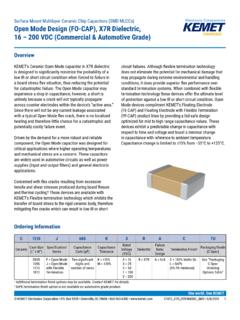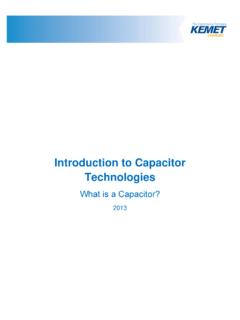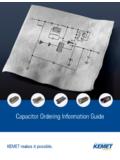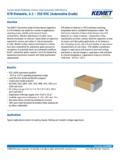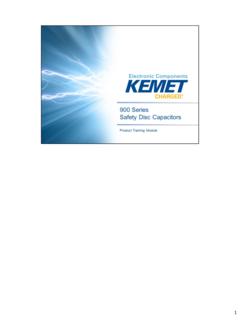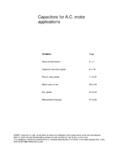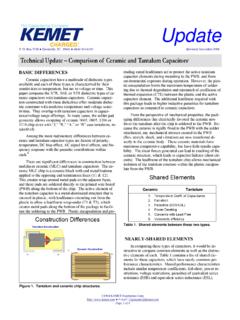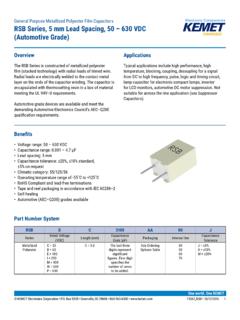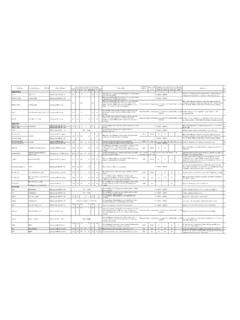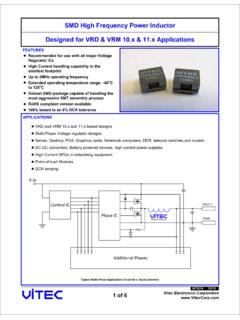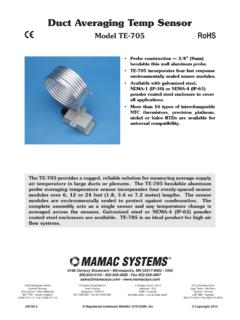Transcription of Development of Electrolytes in Aluminium Electrolytic ...
1 The Development of Electrolytes in Aluminium Electrolytic capacitors for automotive and high Temperature Applications Zongli Dou, Rong Xu, Alfonso Berduque Research and Development Department, BHC Components LTD (KEMET), 20 Cumberland Drive, Granby Industrial Estate, Weymouth, Dorset DT4 9TE, United Kingdom. Telephone: 0044 1305 830724. Facsimile: 0044 1305 760670. E-mail: Abstract Various Electrolytes for use in Aluminium Electrolytic capacitors , working in automotive applications and other industrial applications where longer lifetimes are desired at 125 C and up to 400 V, have been developed or tested. These Electrolytes are based on butyrolactone as a major solvent and organic dicarboxylic acids neutralised with organic bases as solutes or conductive salts. Effects of temperatures from -55 to +125 C on the parameters such as conductivity and dielectric breakdown voltages of the Electrolytes have been investigated using conventional laboratory techniques.
2 The initial work has been concentrated on the Development of 40, 63 & 400 V working Electrolytes . Endurance tests showed reliable performance working over 6000 hours for 40 & 63 V and 4000 hours for 400 V in screw terminal capacitors with ripple current applied at the upper category working temperature. The Development of 100 and 200 V working Electrolytes is currently in progress. The key technologies necessary in the Development of Electrolytes and the effects of the resultant electrolyte on the overall performance of capacitors , such as dielectric breakdown voltages and stability during endurance testing, are discussed. 1. Introduction An increasing demand of electronic components suitable for automotive industries, 1 drive industries and other potential industrial applications for longer lifetimes has driven the Development of Aluminium Electrolytic capacitors operating at high temperatures. The overall performance of Aluminium Electrolytic capacitors for high temperature applications depends mainly on the properties and capabilities of a non-aqueous electrolyte or fill electrolyte used, 2 among other important items such as anode and cathode foils.
3 Much industrial effort has thus been made in the study of Electrolytes . However, few studies associated directly with electrolyte Development , electrolyte parameters and capacitor performance have been published. This work presents the Development of Electrolytes in Aluminium Electrolytic capacitors with an operating voltage range of 40, 63, 100, 200 and 400 V, for automotive and other industrial applications at high temperature up to 125 C. The general requirements for an electrolyte with capability to work at 125 C include: - Excellent reliability at operating voltages, and dielectric breakdown voltages greater than working voltages; 3. - Appropriate anodizing capability to form the edges of the anode and tab foils, as well as to heal any flaws on the Aluminium oxide;. - Good ionic conductivity to reduce ESR;. - Remarkable chemical stability during capacitor application at working voltage at 125 C;. - Optimum pH values and outstanding chemical compatibility with Aluminium foil, papers, plastic deck, rubber seal ring.
4 - Extended working temperature ranges, from -55 to 125 C;. - Excellent wettability and swellability to papers at impregnation, , with reduced surface tension & viscosity;. - Reduced vapour pressure to minimise the internal pressure at 125 C;. - Environmentally friendly and cost effective. 2008 Electronic Components Assoc., Inc., Arlington, Virginia, USA. CARTS Europe 2008 Conference Proceedings, CARTS-Europe Conference, Helsinki, Finland, 20-23 Oct. Page 1 of 11. 2. Experiments electrolyte Preparations, Measurements and Tests All Electrolytes developed in this work were based on Butyrolactone (BLO) solvent, which has a melting point of -45 C. and a boiling point of 204 C sufficiently well above the capacitor highest working temperature of 125 C. The solutes used were different conductive salts, acids and bases, and also some additives such as corrosion inhibitors and hydrogen absorbers. A certain portion of solid solutes were added to a container containing BLO based solvent and other liquid ingredients, followed by stirring and heating up to dissolve the solid solutes.
5 The solution was maintained at a certain temperature with stirring to reduce the water content before cooling down to room temperature for parameter measurement. Parameters of the resultant electrolyte , , water content, conductivity, pH, dielectric breakdown voltage and density were measured before further tests. The water content of the electrolyte was measured using a Karl Fisher titration (AQUAPAL. III titration instrument); the conductivity and pH using a PHM220 Lab pH meter and a CDM210 Conductivity meter, both from MeterLab. The dielectric breakdown voltage was determined using an in-house fabricated dielectric breakdown voltage system, by applying a constant current of 3 mA to a pre formed anode foil cut into the size of 5 4 cm in a testing electrolyte . The density of an electrolyte was measured using a density bottle method, , filling one bottle with an electrolyte and another bottle with water as a reference with a density of gram cm-3, and measuring the respective masses at a constant temperature of 20 C.
6 Capacitor Preparation and Endurance Tests The completed windings, after winding both anode and cathode foils with tab foil attached and simultaneously interleaved with absorbent papers and attached to a plastic deck or cap with Aluminium terminals, were impregnated with an electrolyte in a 10 litre stainless steel vacuum / pressure vessel. Each impregnated winding was then sealed in an Aluminium can, aged up in the Laboratory before initial capacitor measurement of capacitance (C), equivalent series resistance (ESR) and impedance (Z). An Agilent 4263B LCR Meter was used for capacitance and ESR measurement at 100 Hz, V at 20 C, and impedance at 10 KHz, V at 20 C. Endurance tests were carried out by application of a constant voltage (DC) with ripple voltage (AC) equivalent to the maximum working voltage to the capacitors connected in pairs in an oven at the upper category operating temperature of 125 C. The constant voltage was provided by a Nemic Lambda GenesysTM GENH600 programmable regulated DC.
7 Power supply, and the calculated maximum allowable ripple current by a lab constructed variable Transformer. An Agilent 34970A Data Acquisition System was used to monitor and record the leakage current time continuously. Each 1000 hours during endurance tests, the capacitors were discharged, cooled down to room temperature, disconnected and removed from the oven before the measurement of capacitance, ESR and impedance at 20 C. The capacitors were then re-placed into the oven, reconnected, reheated to 125 C and the endurance tests resumed until next 1000 hours' interval. 3. Results electrolyte Tests: 40, 63, 100, 200 and 400 V. electrolyte Parameters The parameters of five Electrolytes , with working voltages at a range of 40, 63, 100, 200 and 400 volts and working temperature at a range of -55 to 125 C, are illustrated in Table 1. These Electrolytes are named as WEY 040, WEY 063, WEY 100, WEY 200 and WEY 400 respectively. 2008 Electronic Components Assoc.
8 , Inc., Arlington, Virginia, USA. CARTS Europe 2008 Conference Proceedings, CARTS-Europe Conference, Helsinki, Finland, 20-23 Oct. Page 2 of 11. Table 1. electrolyte parameters. electrolyte Water pH Breakdown V Density -1. (wt%, at 25 C) (mS cm , at 25 C) (at 25 C) (V, at 90 C) (g cm-3, at 20 C). WEY-040 74 WEY-063 82 WEY-100 134 WEY-200 265 WEY-400 492 Conductivity Temperature Relationships The temperature dependence of conductivity for the Electrolytes is shown in Figure 1. electrolyte WEY 040 revealed the uppermost increase of conductivity with temperature from -55 to 125 C, followed by electrolyte WEY 063 presenting slower but similar slope to electrolyte WEY 040. electrolyte WEY 100 demonstrated marginally faster increase than WEY 200 in conductivity with temperature but significantly slower than electrolyte WEY 063. In comparison, electrolyte WEY 400 showed the least increase in conductivity with temperature under similar conditions.
9 Figure 1. Conductivity temperature relationships of the Electrolytes . Dielectric Breakdown Voltage Temperature Relationships Figure 2 shows the dielectric breakdown voltage ranges for all these Electrolytes , as a function of the temperature. The breakdown voltage of the Electrolytes slightly, if not insignificantly, decreases with the increase of temperature, perhaps due to the increased conductivity of the electrolyte at higher temperature. Increased temperature improves the dissociation constant of ion pairs and thus promotes more active ions in the electrolyte . In general, the breakdown voltage of the electrolyte is practically independent of the temperature. In other words, the dielectric breakdown voltage does not change significantly with the temperature, suggesting the suitability of application of these Electrolytes over a wide range of temperature at the rated voltages under the testing conditions. 2008 Electronic Components Assoc.
10 , Inc., Arlington, Virginia, USA. CARTS Europe 2008 Conference Proceedings, CARTS-Europe Conference, Helsinki, Finland, 20-23 Oct. Page 3 of 11. Figure 2. Dielectric breakdown voltage temperature relationships of the Electrolytes . Dielectric Breakdown Voltage Conductivity Relationships The relationships of conductivities and breakdown voltages for the five Electrolytes are further illustrated in Figure 3. The breakdown voltages for Electrolytes WEY 040, WEY 063, WEY 100 and WEY 200 gave evident linear relationship with the logarithm of conductivity of the working electrolyte . In comparison, the breakdown voltages of electrolyte WEY 400. give less evident linear relation of the logarithm of breakdown voltage and conductivity, perhaps due to the different electrolyte composition of electrolyte WEY 400. Figure 3. Dielectric breakdown voltage conductivity relationships of the Electrolytes over a range of temperatures from 25 to 125 C.
